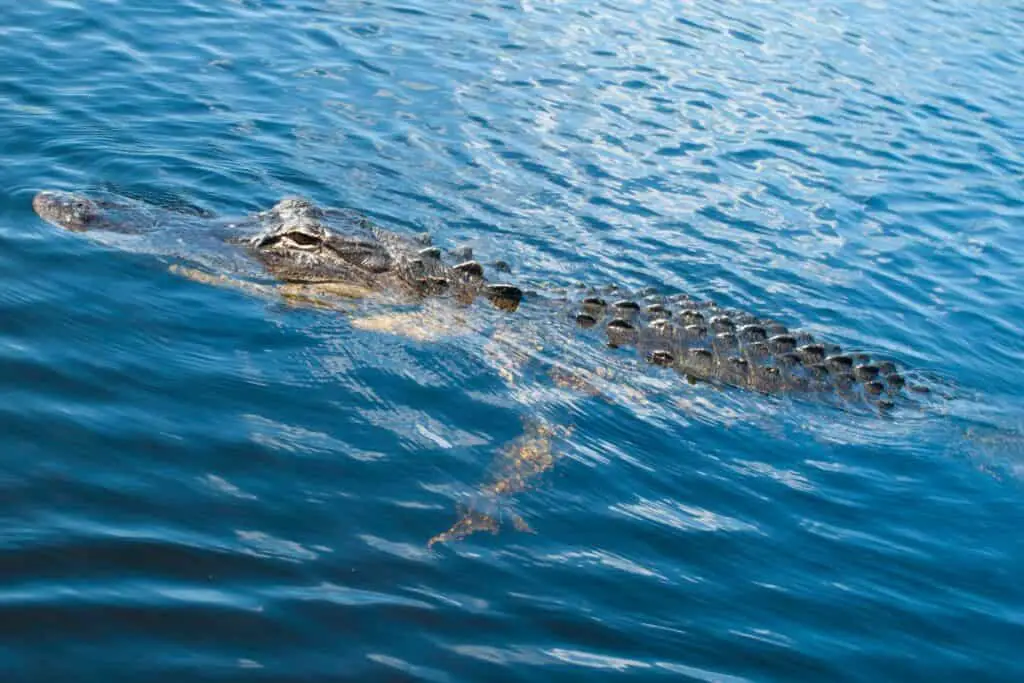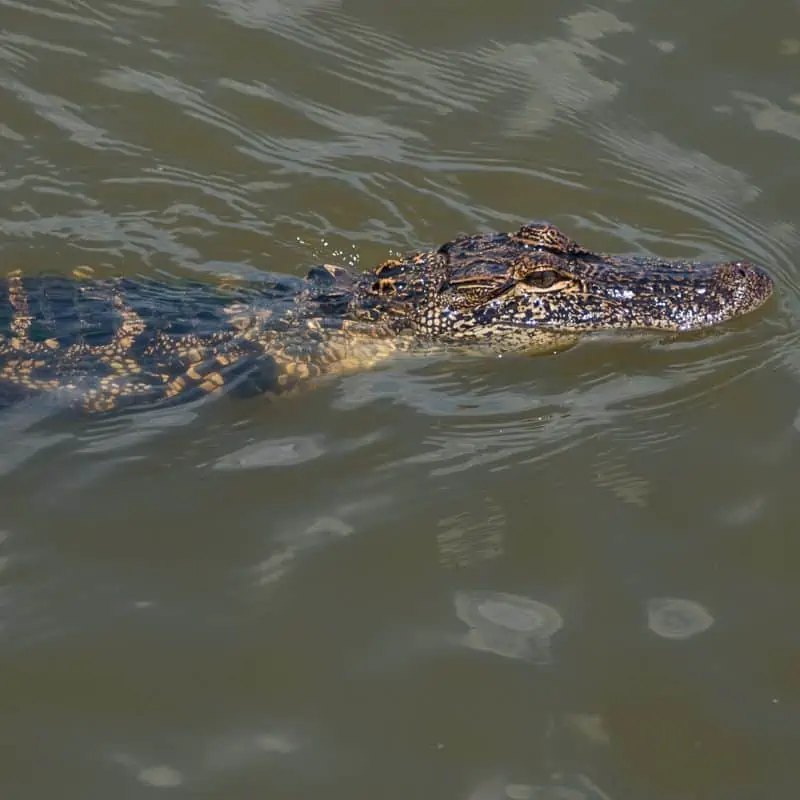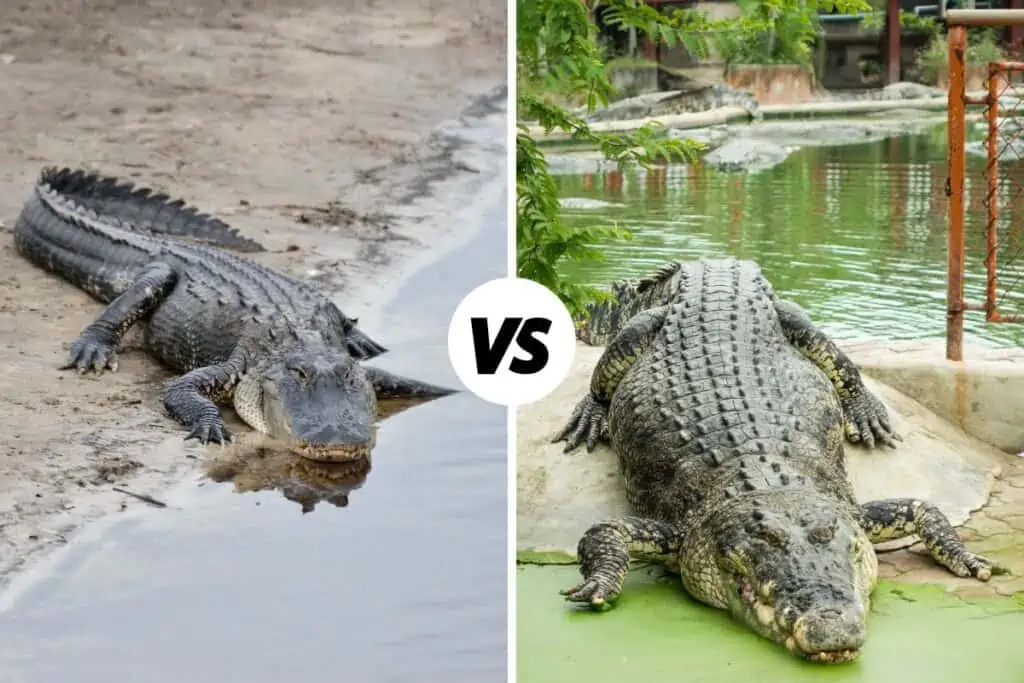It is perfectly normal to swim in the ocean and, for a split second, envision a dangerous scenario, like coming face-to-face with an alligator. But is there any foundation for such a fear? Do alligators live in saltwater?
Alligators do not live in saltwater since they are predominantly freshwater reptiles. However, alligators can adapt to their environment and tolerate saltwater. This tolerance enables them to survive in saltwater for short periods, ranging from a few hours to a few days.
Like with many aspects of nature, it isn’t easy to give one definitive answer to an alligator’s habitat and living conditions. We should try to understand the limits within which alligators move between different water sources and the reasons behind them.

Where Do Alligators Live?
In the U.S., alligators are more prevalent in southeastern states. They spend most of their time in freshwater sources, like swamps, lakes, rivers, streams, and ponds.
Yet, they spend some time in brackish water (somewhat salty) and a little time in saltwater.
So, although they do not technically live in saltwater, they visit water bodies with salt content for several hours or days at a time.
Why Don’t Alligators Live In Saltwater?
Unlike crocodiles, alligators are not biologically adapted to living in saltwater.
Crocodiles, for example, have special salt glands that excrete higher amounts of salt from water – essentially nullifying the salt in the water. Alligators do not possess these salt glands, making them less tolerant of saltwater environments.
These salt-secreting glands can be found on the tongue of crocodiles. Through a pump action, sodium and other seawater ions are moved from the reptile’s blood into the gland, emitting it as a concentrated salt solution.
Younger alligators have a particularly challenging time in saltwater since their skin isn’t as thick as adults.
Reasons Alligators Go Into Saltwater
Alligators sometimes go into saltwater to feed.
They are opportunistic feeders, with adults eating fish, turtles, wading birds, snakes, frogs, and small mammals. They might even feast on smaller alligators if they find them near their habitat.
To capture blue crabs or saltwater fish, like sharks and rays, alligators need to enter the sea to find them.
Although alligators are freshwater reptiles, their feeding habits significantly impact saltwater ecosystems like salt marshes.

When alligators follow the tides, they transport nutrients. For example, when more food flows into saltwater ecosystems during spring tides, alligators move there to hunt. They then carry nitrogen and phosphorus, contained in the food they eat and excrete, to these areas.
This feeding habit helps maintain a balanced ecosystem and stabilizes the number of other animal populations.
When Do Alligators Go Into Saltwater?
Ecologists have determined that alligators remain in marine habitats for extended periods around spring tides.
Spring tides occur right after a full or new moon when the difference between high and low water levels is at its greatest. The extreme difference in water levels displaces prey, such as fish and crustaceans, to low water depths.
This results in a high concentration of these animals in one area in relatively shallow water, setting up the perfect conditions for an alligator to capture and feast on its prey.
How Can Alligators Survive In Saltwater?
Firstly, alligators tend to move between saltwater and freshwater ecosystems to rebalance their salt levels, enabling them to survive.
Alligators’ other ‘weapon’ when entering a saltwater environment is their bodies. They can shut their nostrils and close off their throat with a cartilage-based shield.
When alligators need to eat while in saltwater, they tip their head upwards to let all the saltwater drain out before they swallow their prey.
When alligators need to drink, they can either tilt their head up to catch rainwater (if the weather plays along) or collect a layer of fresh water that floats on top of saltwater after a rain shower.
American Alligators Vs. Saltwater Crocodiles
It has been well established that alligators do enter saltwater environments. They are regularly spotted on the southeast coastal plains coast in the U.S.
Still, it is worth confirming your suspicions should you ever spot what looks like an alligator in the sea.
You can observe and consider seven differences to differentiate between an American alligator and a saltwater crocodile.

1. Color
A quick way to tell an American alligator and a saltwater crocodile apart is by looking at their color.
Adult saltwater crocodiles are generally olive green, with light tan or grey areas, whereas young crocodiles are pale yellow with black stripes and spots on the body.
Adult alligators are much darker – almost black – with a lighter underside. Younger alligators will have light-colored lines on their sides.
Another feature that appears different in color is the dome pressure receptors (regulates water pressure) on reptiles’ skin. The saltwater crocodile receptors are translucent, whereas American alligators’ receptors look like tiny black spots near their jaw.
2. Size
Saltwater crocodiles can grow to 23 feet, making them much more prominent in size than American alligators. The latter only reaches about 8 feet (females) or 11 feet (males).
However, this is one of the more complicated features to spot if you see these reptiles from a distance.
3. Shape Of Their Snouts
All crocodiles have pointed, V-shaped snouts, which are very wide or narrow. It will, however, always have the same pointed shape. Crocodiles also have an overbite and underbite that allows us to see both the top and bottom teeth.
Alligators have large, broad snouts shaped like the letter U, and their jaw closes downwards so you can see only their top teeth.
4. Their Bite
The saltwater crocodiles have sharp, pointy teeth, and their bite strength is approximately 3700 psi. The American alligator’s teeth are cone-shaped rather than pointed, and their bite strength is about 2500 psi.
5. Location
The American alligator can survive colder temperatures than the saltwater crocodile, making them adapt to northern regions reaching North Carolina. In contrast, a crocodile needs warmer temperatures to remain active and can be found mainly on the southern tip of Florida.
Saltwater crocodiles are not native to the Americas, so odds are, if you’re in the US, that giant reptile you’re looking at is not a salty.
6. Scarcity
Although alligators and crocodiles belong to the same order (Crocodilia), they do not belong to the same family.
There exist 13 species of crocodiles (Crocodylidae), and they are found in the United States, Australia, India, Africa, and Southeast Asia. Alligators (Alligatoridae) only make up 2 of the seven species that make up this family, making them few and far between.
7. Aggression
Saltwater crocodiles have a reputation for being one of the most aggressive species in the world. Even baby saltwater crocodiles are aggressive, at the same level as adults who spend their entire lives in the wild.
On the other hand, an alligator is probably more afraid of humans than we are of them. They would only attack when disturbed or protect their eggs or young offspring.
Again, this might (hopefully) not be a feature you will witness in person, making it a slightly less practical comparison when trying to distinguish between an alligator and a crocodile.
Final Thoughts On Alligators In Saltwater
Knowing that there might be alligators in freshwater wetlands and salt marshes along southeast coast beaches should not alarm you.
Still, you might do well to keep your eyes open.
Not only to keep yourself out of harm’s way but to increase the chances of spotting an alligator in real life.
